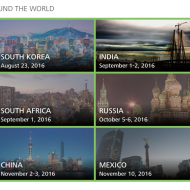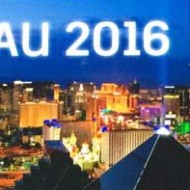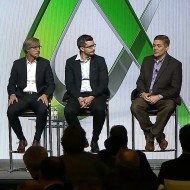This year, Autodesk University introduced a new series of Innovation Forums. These TED-like events are designed to inspire and energize all of us to think more creatively and in entirely new ways. The Creativity 2.0 session did not disappoint!
Autodesk Fellow Tom Wujek set the stage by talking about the future of creativity and how it impacts our personal and professional lives and the industries we serve. Technology is growing exponentially, transforming industries and the way we imagine and envision possibilities. The number of processors produced on the planet last year is greater than the number of grains of rice grown in the same period! The growth in processing power and availability improves our productivity and democratizes creativity.
Tom said that the impact of technology is also diluting our attention. Tools—from pens to computers—become part of our nervous system. A recent study showed that how we get information from the web is different from how we get it from paper. We can read the Internet much faster, but we remember less.
Technology has unexpected consequences. Human brain capacity doubles every 160,000 years, but computing power doubles every year. The technology is rewiring our brains. We see the world through the tools we use.
On another front, rapid technological change is creating turbulence and chaos in our industries. We need to reinvent our businesses. How does the auto industry change when traditional manufacturing is replaced by 3D printing? This technology is coming: The Urbi is the world’s first 3D-printed vehicle and it works.
The creativity level is growing just like technology. We are literally changing our brains by using new tools. What will that mean for the next generation of users? Kids are already going up to magazines and TVs, trying to use them like iPads®. When these objects don’t respond as expected, the kids think these objects are broken!
With that Tom introduced Sir Ken Robinson.
Out of Our Minds: Learning to Be Creative
Sir Ken Robinson explained that the tools available today are awe inspiring and are helping to generate a revolution. Sir Ken said that the current generation faces challenges no other generation has had to deal with—and that the outcome is unpredictable. Comparing today’s world with the arc of his own life, Sir Ken said that the world he was born into was very different. There were no Best Buys, and his family bought only 4 electronic items when he was young: a record player, a telephone with party line (Sir Ken said that listening to the party line was like an early form of Facebook), a TV (his brother Neal was “the remote”), and a radio. That was it.
It is impossible to predict the cultural impact of technology. Sir Ken pointed out that people thought TV would never replace the radio because people cannot watch it while they do other things. Instead, TV changed the nature of culture. People made time for it.
Another factor to consider: the size and scale of the human population. Serious statisticians estimate that the total number of humans that have been on the planet throughout history ranges from 60 and 110 billion. In the last 300 years, humans have gone off in a different direction from the rest of the creatures on our planet. Population has been growing exponentially and has reached or will soon reach 7 billion. How many can our planet support? Estimates range from 15 billion if we consume at the level of Rwandans vs. 1.2 billion at US consumption levels. This is unsustainable. We’ve entered a new era, the Anthropocene. We have to solve the problems we have created—by being more creative.
Sir Ken continued by pointing out that our current education systems tacitly suppress creativity. Imagination helps to answer the puzzle of why humans have come to dominate the planet. Imagination is the engine of human cultural change. There’s a lot we can do to make people more creative. We’re born with the powers of imagination and creativity, but we don’t all develop them. We need to revolutionize our mass education systems by personalizing and customizing education for each child.
Interconnectivity: The Evolution of Digital Culture
Mark Foster Gage took the stage next to talk about how technology is limiting creativity. Mark said that if we focus too much on individual software packages, these technologies get in the way of cross pollination between different professions and industries. At the same time, software can function like a Rosetta Stone between disciplines. Mark pointed out that automotive designers think about surfaces very differently than architects do. He experiments with using automotive software to design buildings. He is creating solar pods that open when the is sun out, but close to protect the surface collectors when it is not. Mark asked, “What if architecture started to think about fashion and jewelry?”, then showed how this idea was already being applied using a building interior made up of mirrored facets designed to show fashion from all angles. Mark closed by encouraging all of us to engage the world in different ways. He said, “The person next to you could be the solution to your problem.”
Welcome to the Lab
Next, Louise Leakey, came on stage to describe the initiative by Autodesk and the National Museums of Kenya. This initiative enables anyone to “visit” the lab, which stores both human fossils and the fossils of animals who lived concurrently with early hominids. You can view 3D models of the fossils, compare them with other hominid species, and generate 3D printouts of fossil replicas. This initiative is allowing people to interact with the fossils in an entirely new way, and gives us all the opportunity to think about where we came from by accessing this collection. Get your hands on the bones at Africanfossils.org.
Building Worlds: Creating Narrative Space through Immersive Design
Next, Alex McDowell talked about the process of creativity in the film industry—specifically about creating a fantasy environment. According to Alex, ideas happen this way: you wake up in the morning with the spark of an idea.
In the upcoming movie Upside Down, two people who live in very different worlds are in love. How do you take an idea like this and use it as the basis to form an alternate world? Alex says the flow of world building goes from inception to prototyping through manufacturing and then finishing. In the end, you visualize a coherent and immersive world.
To create a world, Alex says, you start with the landscape (the film’s landscape is based on Montreal). You map the world, then create the society, define the social politics, and develop the culture.
Alex showed how he used Autodesk® Maya® on the project.
What I Do for Fun: Tools, Education, and Creativity
Saul Griffith of Otherlab took us on a rousing journey of imagination and creativity. According to Saul, Otherlab is “the place where other things get done” and proceed to show us “What I do for fun.” One of his marvelous inventions is a boat propelled at amazing speeds by a 20-meter kite 400 feet above the boat. The boat includes sensors that detect wave height.
He showed us one of his earlier efforts—Makani Power’s autonomous flying kite that generates power. The device is essentially a &ldqup;turbine on the wing.” The device can be made for much less than standard wind generators.
Saul said, “We’re always doing something so unusual that existing design tools don’t work for us.” One of the most entertaining, yet seemingly practical, innovations is Otherlab’s Pneubots. Saul described them as “walking bags of fabric.” These soft, compliant, organic designs offer super-high strength-to-weight ratios. He showed us a 1/2-lb robot picking up a 50-lb bucket. And unlike traditional steel robots, one of the largest inflatable robots costs only about $5000 to build.
Another innovation is the Heliostat Actuator. This device is based on origami and offers a lower-cost way of gathering sunlight.
Saul concluded that “it’s time for an intervention in engineering education.” First, this kind of education needs to start way before age 18. We need to let children decide what they want to make and give them simple tools for producing things. And we need to change the process by which things are designed and made.
–sandy



